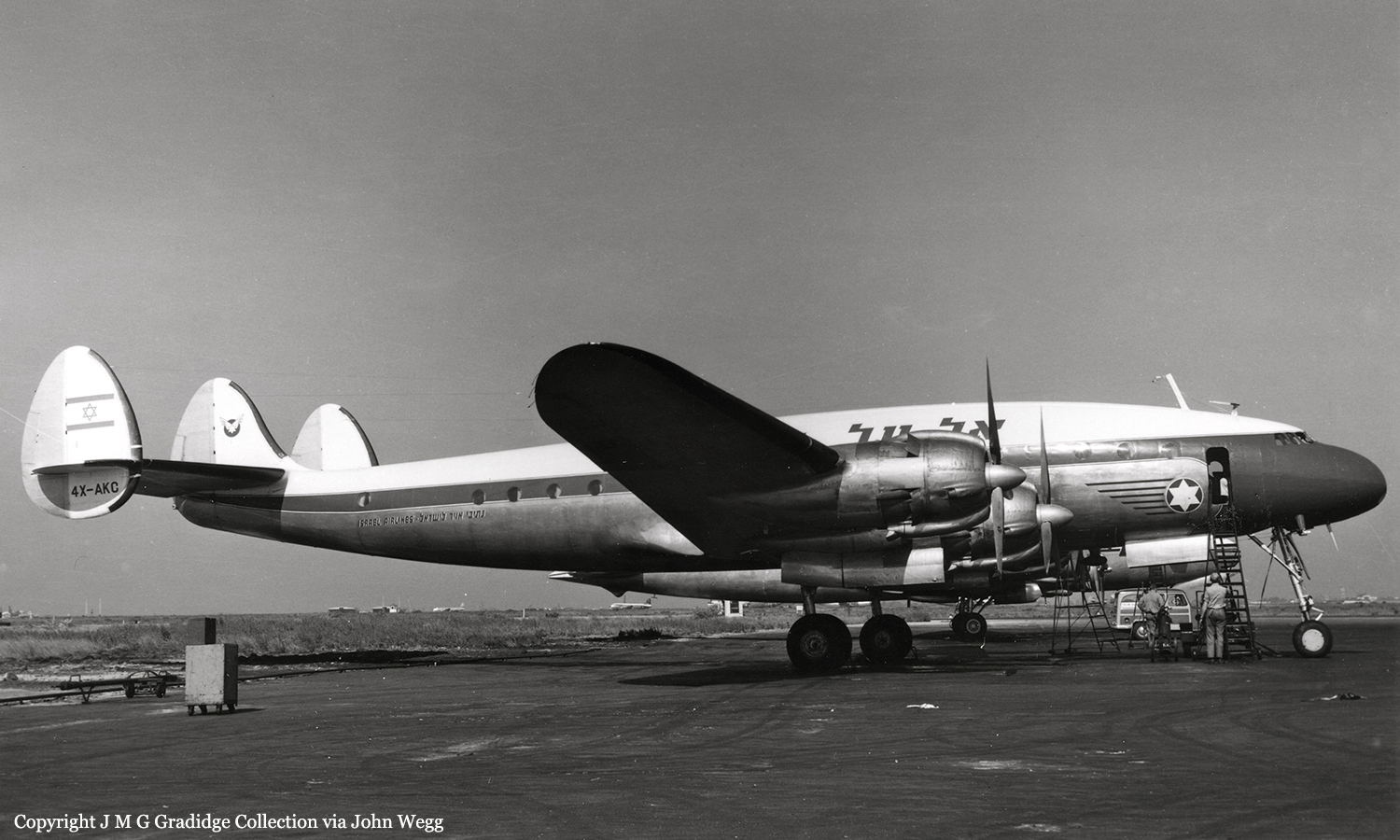Country
Crash of a Lockheed L-049 Constellation near Cruzeiro do Sul: 9 killed
Date & Time:
May 29, 1972
Registration:
PP-PDG
Survivors:
Yes
Schedule:
Cruzeiro do Sul - Rio Branco
MSN:
2037
YOM:
1946
Crew on board:
3
Crew fatalities:
Pax on board:
15
Pax fatalities:
Other fatalities:
Total fatalities:
9
Circumstances:
Because of a lack of fuel at Cruzeiro do Sul Airport, the airplane was grounded for four days. Eventually, two fuel trucks were dispatched to the airport and the aircraft could be refueled directly from the trucks. Few minutes after takeoff, while cruising at an altitude of 8,000 feet, the engine n°3 failed, followed 10 minutes later by a second engine. Some of the cargo was jettisoned but the aircraft was still losing altitude. The captain decided to attempt an emergency landing on the Cruzeiro do Sul - Tarauacá highway when the airplane struck trees and crashed in a wooded area. Nine occupants were killed, including all three crew members, and nine other occupants were injured. The aircraft was destroyed. It was later confirmed that another aircraft that had been refueled just after PP-PDG had to reject its takeoff because of an engine failure.
Probable cause:
Refueling directly from the trucks without allowing sufficient time for the fuel to settle.
Crash of a Lockheed L-049 Constellation on Peak Genoa: 85 killed
Date & Time:
Mar 1, 1964 at 1129 LT
Registration:
N86504
Survivors:
No
Schedule:
Oakland – San José – Salinas – South Lake Tahoe
MSN:
2025
YOM:
1946
Flight number:
PD901A
Crew on board:
4
Crew fatalities:
Pax on board:
81
Pax fatalities:
Other fatalities:
Total fatalities:
85
Captain / Total hours on type:
3266.00
Copilot / Total hours on type:
1353
Aircraft flight hours:
45629
Circumstances:
The Paradise Airlines Lockheed Constellation operated Flight 901A from Oakland (OAK) to Tahoe-Valley Airport (TVL) via Salinas (SNS) and San Jose (SJC). The aircraft departed Oakland at 08:43 and was ferried to Salinas, arriving at 09:11. The flight departed at 09:27 with 18 passengers and arrived at San Jose at 09:46. The Constellation departed was airborne again at 10:40 on a VFR flight plan. After becoming airborne, the crew requested and received an IFR clearance via airways Victor 6 South to Sacramento, Victor 6 to the Lake Tahoe VOR, to maintain 11,000 feet. The company prepared flight plan then called for a VFR flight to the Tahoe Valley Airport because there was no approved IFR approach procedure for the destination. At 10:57 Flight 901A was in radio communication with Paradise Flight 802 which was outbound from the Tahoe Valley Airport. The captain of Flight 802 advised the crew of Flight 901 that he had encountered "...icing at 12,000 (feet) ... there were snow showers over the lake and clouds topping mountains in the vicinity ...". Flight 901A then climbed to a cruising altitude of 15000 feet. The crew of Flight 901A contacted the Paradise Airlines passenger agent at the Tahoe Valley Airport at 11:27. At this time he gave them the 11:00 Tahoe Valley weather which was: Estimated ceiling 2,000 feet overcast; 3 miles visibility; snow showers; temperature 32°; dewpoint 32°; wind from 210°; 10 knots, gusts to 15 knots; altimeter 29.97. He also asked the crew to call the company if they decided to land at Reno, Nevada rather than Tahoe Valley. The crew acknowledged this transmission with "will do." The crew apparently decided to abandon the approach. They took up a heading which took them towards the high terrain east of the lake. It is very likely that from their position over the Tahoe VOR they were able to observe the VFR conditions that existed east of Lake Tahoe on the leeward side of the mountains. Additionally, investigators assumed that the first officer was aware of the existence of Daggett Pass and considered it an access to VFR conditions beyond the pass. An altitude of 9,000 feet would provide about 1,500 feet terrain clearance through the center of the pass. Then, either because they believed they had sufficient altitude to clear the terrain or because they were unable to climb higher due to structural ice, the aircraft leveled off. At that time the aircraft struck several trees on the west slope of a ridge of Genoa Peak at approximately 8,675 ft, slightly right-wing-low in a nearly level flight attitude. The airplane broke up, killing all aboard.
Probable cause:
The Board determines that the probable cause of this accident was the pilot's deviation from prescribed VFR flight procedures in attempting a visual landing approach in adverse weather conditions. This resulted in an abandoned approach and geographical disorientation while flying below the minimum altitude prescribed or operations in mountainous areas.
Final Report:
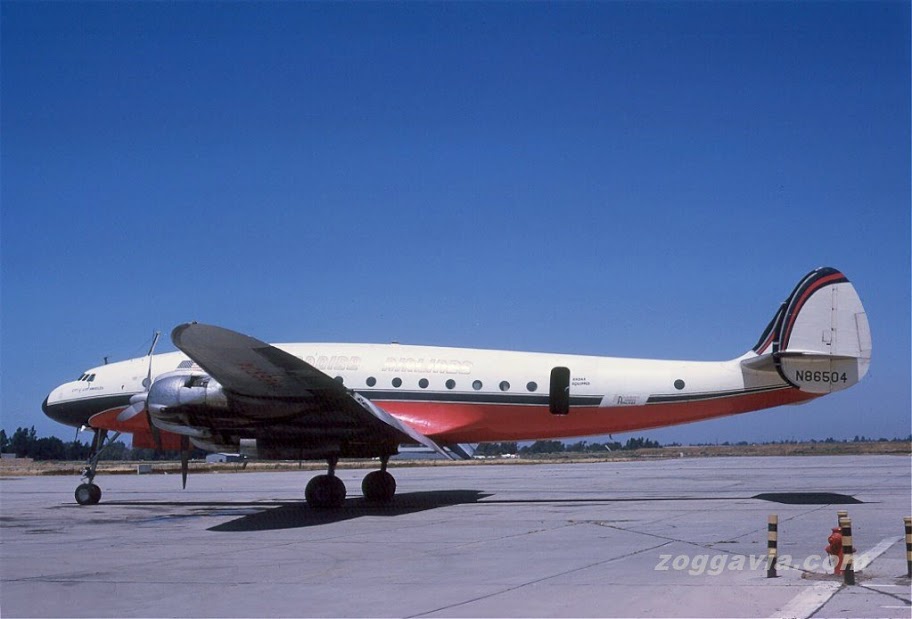
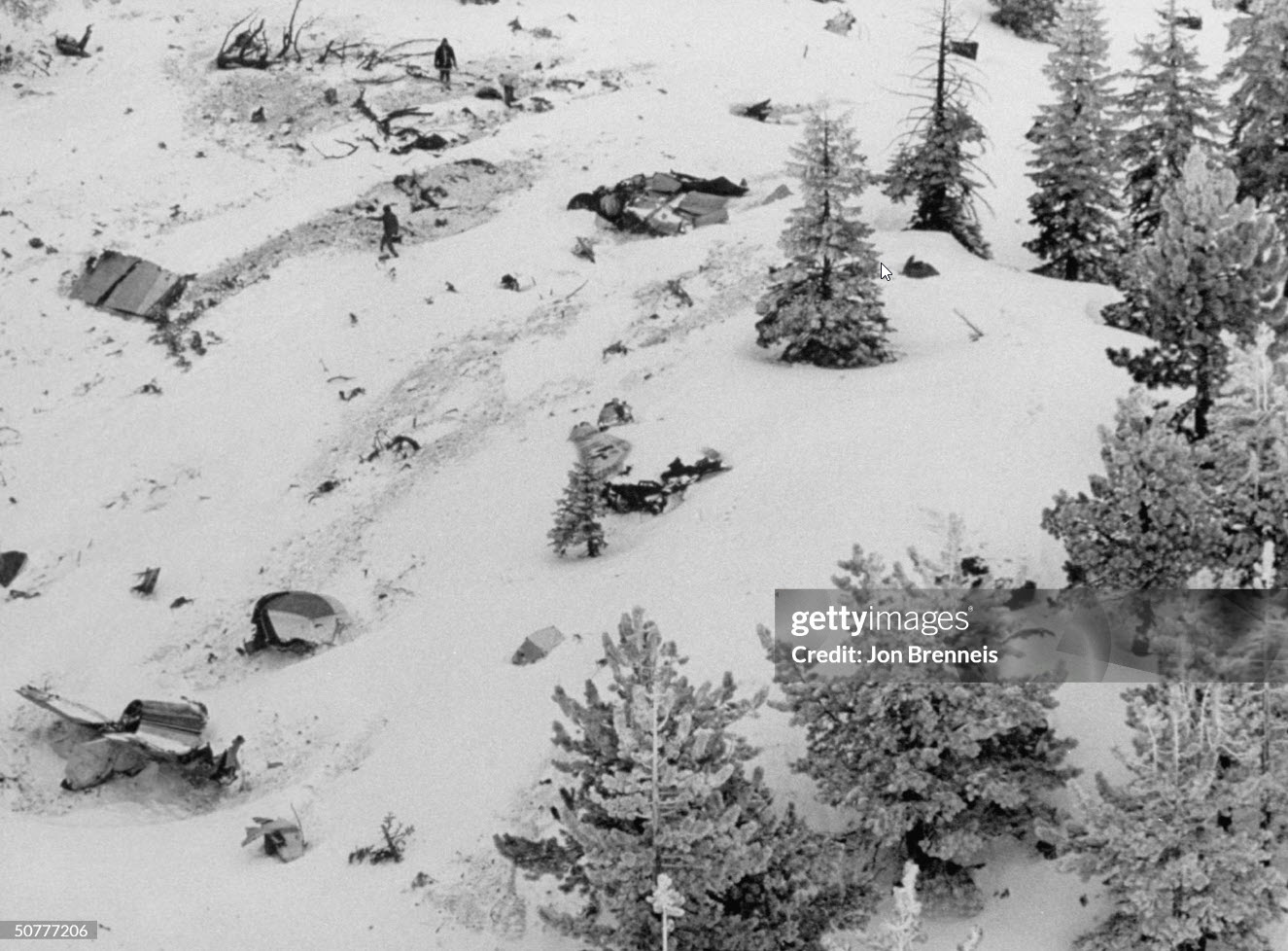
Crash of a Lockheed L-049-46-21 Constellation near Manaus: 50 killed
Date & Time:
Dec 14, 1962 at 0020 LT
Registration:
PP-PDE
Survivors:
No
Schedule:
Belém – Manaus
MSN:
2047
YOM:
1946
Crew on board:
7
Crew fatalities:
Pax on board:
43
Pax fatalities:
Other fatalities:
Total fatalities:
50
Circumstances:
The Panair Constellation departed Belém at 02:31 GMT for a 3-hour flight to Manaus-Ponta Pelada Airport. The plane followed the Amber 1 airway and contacted Manaus at 05:04, reporting six minutes out. At 05:19 the flight crew asked Manaus whether the plane's engines could be heard. Manaus replied negative and asked the reason for the question. Nothing more was heard from the flight, which appeared to have crashed 45 km from Manaus. The Constellation named 'Estevao Ribeiro Baiao Parente' was completely destroyed and all 50 occupants were killed.
Probable cause:
The cause of the accident was not determined.
Final Report:
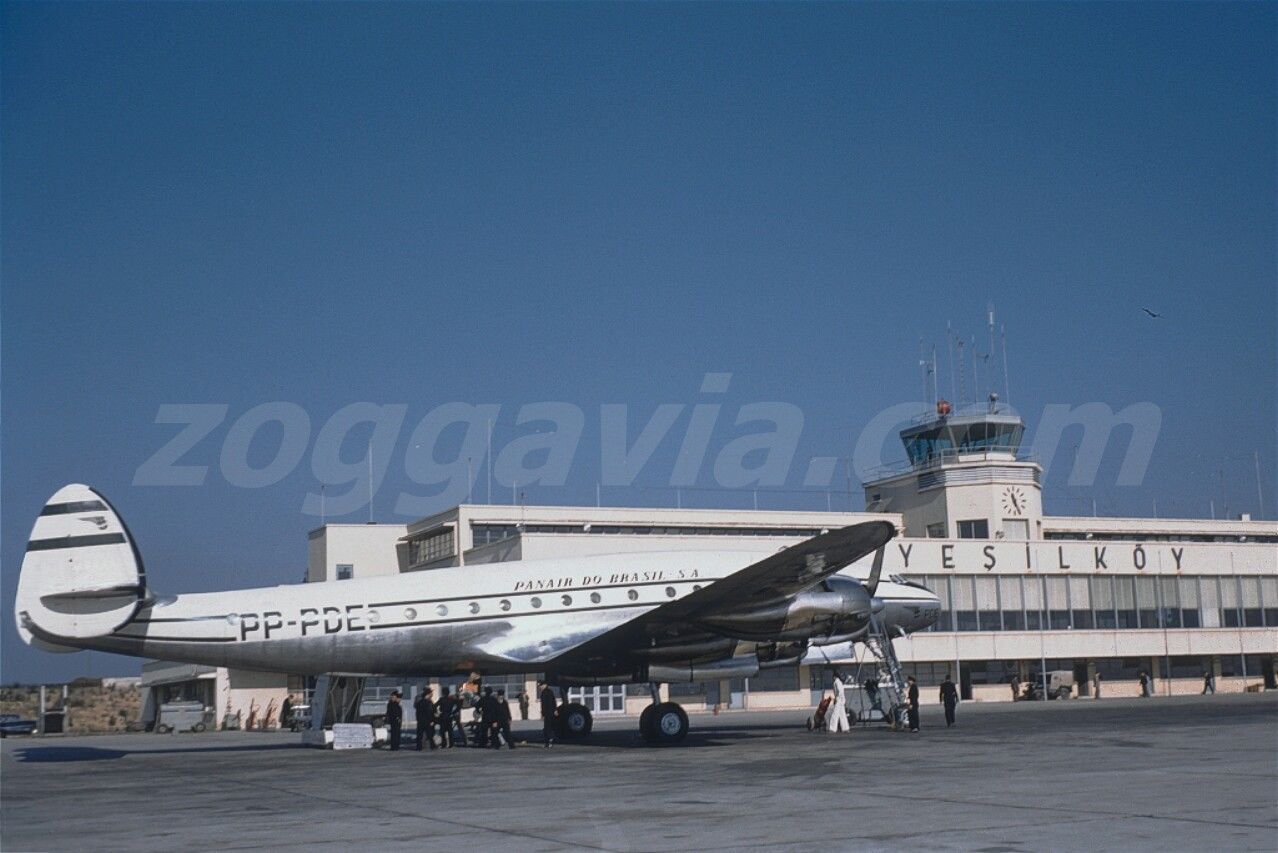
Crash of a Lockheed L-049 Constellation in Rio de Janeiro
Date & Time:
Mar 3, 1962
Registration:
PP-PCR
Survivors:
Yes
MSN:
2060
YOM:
1946
Crew on board:
0
Crew fatalities:
Pax on board:
0
Pax fatalities:
Other fatalities:
Total fatalities:
0
Circumstances:
The crew encountered technical problems while approaching Rio de Janeiro-Galeão Airport and was unable to lower the nose gear. The landing procedure was completed with the nose gear retracted and the airplane slid on its nose for dozen yards before coming to rest. There were no injuries but the aircraft was written off.
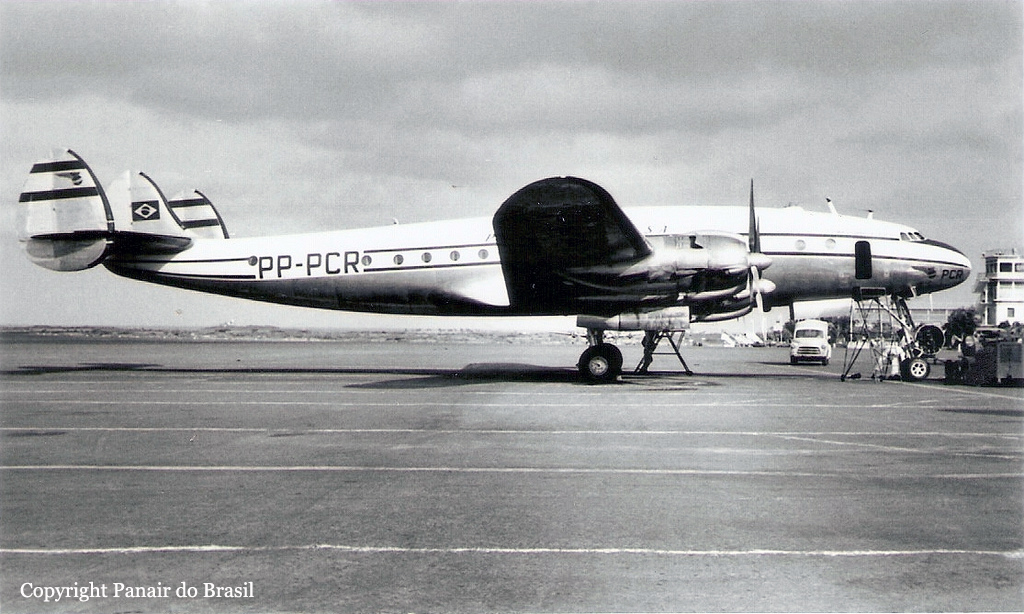
Crash of a Lockheed L-049E Constellation in Richmond: 77 killed
Date & Time:
Nov 8, 1961 at 2124 LT
Registration:
N2737A
Survivors:
Yes
Schedule:
Newark – Wilkes Barre – Baltimore – Columbia
MSN:
1976
YOM:
1946
Flight number:
IM201
Crew on board:
5
Crew fatalities:
Pax on board:
74
Pax fatalities:
Other fatalities:
Total fatalities:
77
Captain / Total hours on type:
293.00
Copilot / Total hours on type:
352
Aircraft flight hours:
32589
Circumstances:
On November 8, 1961, at 2124 e.s.t., an Imperial Airlines, Lockheed L-49, crashed and burned during an attempted landing at Byrd Field, Richmond, Virginia. Seventy-four passengers and three flight crew members died as a result of carbon monoxide poisoning. Two members of the flight crew escaped from the burning wreckage. The aircraft was totally destroyed. The flight was en route from Baltimore, Maryland, to Columbia, South Carolina, when in the vicinity of Richmond the crew as a result of fuel mismanagement allowed the Nos. 3 and 4 engines to run the No. 4 fuel tank dry. When they were unable to restart the two engines, they feathered the propellers and elected to land at Richmond. As the flight approached the airport for its intended landing on runway, Captain Greenlee, who was acting as copilot, without warning to the captain in command, turned the aircraft to attempt a landing on runway 02 and put the landing gear selector in the down position. When the landing gear did not extend due to crew mismanagement of the hydraulic system, a go-around was attempted with only the Nos. 1 and 2 engines operating. During the go-around, which was poorly executed, the No. 1 engine failed as a result of overboosting. With only one engine remaining in operation it was impossible to maintain flight. The crew also misjudged the aircraft flight path, overshot the extended centerline of runway 33 and crashed one-half mile to the left of the final approach path and one mile from the runway threshold.
Probable cause:
The Board determines the probable cause of this accident was the lack of command coordination and decision, lack of judgment, and lack of knowledge of the equipment resulting in loss of power in three engines creating an emergency situation which the crew could not handle.
Final Report:
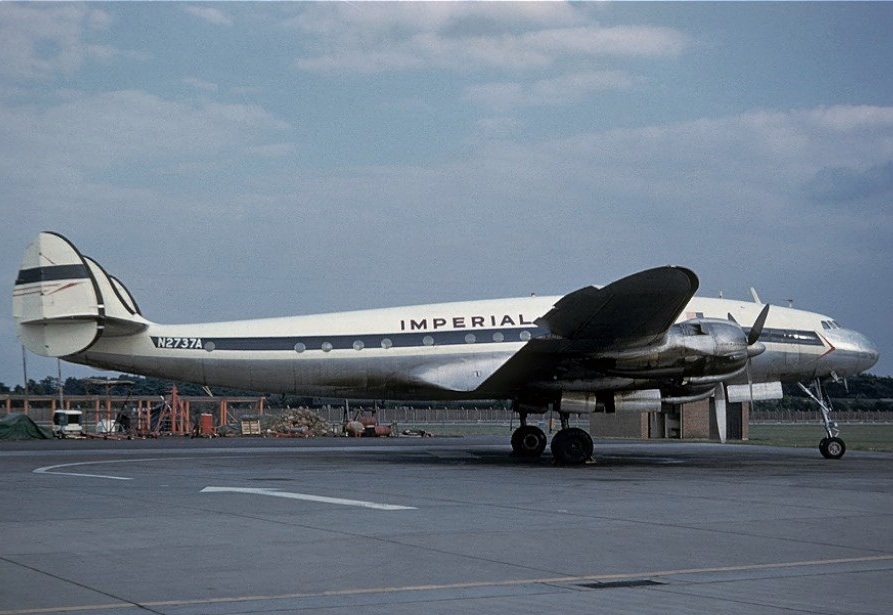

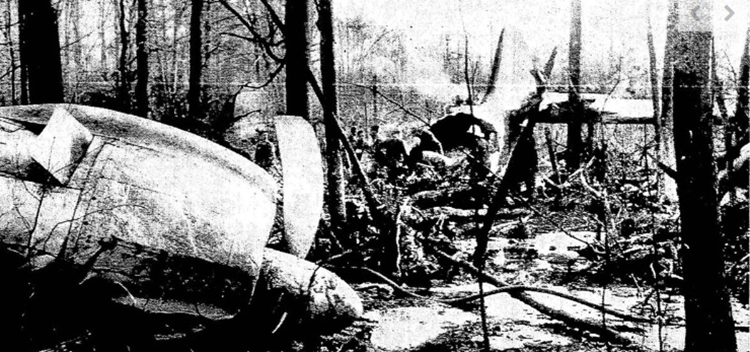
Crash of a Lockheed L-049 Constellation in Hinsdale: 78 killed
Date & Time:
Sep 1, 1961 at 0205 LT
Registration:
N86511
Survivors:
No
Schedule:
Boston – New York – Pittsburgh – Chicago – Las Vegas – Los Angeles – San Francisco
MSN:
2035
YOM:
1945
Flight number:
TW529
Crew on board:
5
Crew fatalities:
Pax on board:
73
Pax fatalities:
Other fatalities:
Total fatalities:
78
Captain / Total hours on type:
12633.00
Copilot / Total hours on type:
1975
Aircraft flight hours:
43112
Circumstances:
During engine runup, Flight 529 was given its air traffic control clearance which was: "cleared to the Las Vegas Airport via Victor 6 Naperville, Victor 8 flight plan route, maintain 5,000 feet." The clearance was acknowledged correctly and TWA Flight 529 departed on runway 22L at 0200, making a right turn out of traffic. The 0200 Midway Airport weather was: scattered clouds at 10,000 feet; high overcast, visibility three miles in haze and smoke; wind south eight knots. The Chicago O'Hare Airport weather at 0200 was: partial obscuration; scattered clouds 15,000 feet; high overcast; visibility two and one-half miles in ground fog and smoke; wind south six knots. Radar contact was established with the flight one minute and 34 seconds after the flight acknowledged takeoff clearance and as the aircraft proceeded outbound in a right turn. At 0204, Flight 529 was observed on radar by the departure controller to be five miles west of Midway Airport proceeding on course. Northwest Airlines Flight 105 was cleared for takeoff on runway 22L at Midway, and took off Immediately. The ground controller observed a flash west of Midway Airport at this time and asked Flight 105 if he had seen a flash. Flight 105 advised that they had seen a flash fire and would fly over the area. As Flight 105 reported over the fire, the radar range was noted to be nine miles west of Midway Airport and the radar return of TWA. Flight 529 had disappeared from the scope. It was later determined that Flight 529 had crashed at this site and that the observed ground fire was the result of the accident. The airplane disintegrated in a field and all 78 occupants have been killed.
Probable cause:
The Board determines that the probable cause of this accident was the loss of an AN-175-21 nickel steel bolt from the parallelogiam linkage of the elevator boost system, resulting in loss of control of the aircraft.
Final Report:
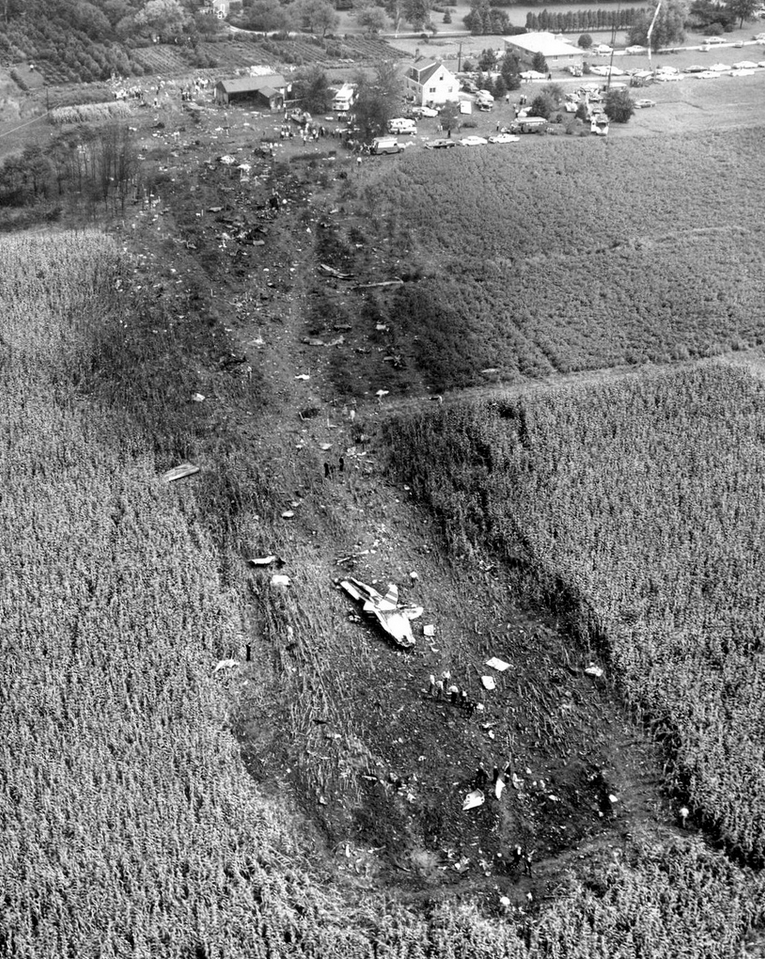
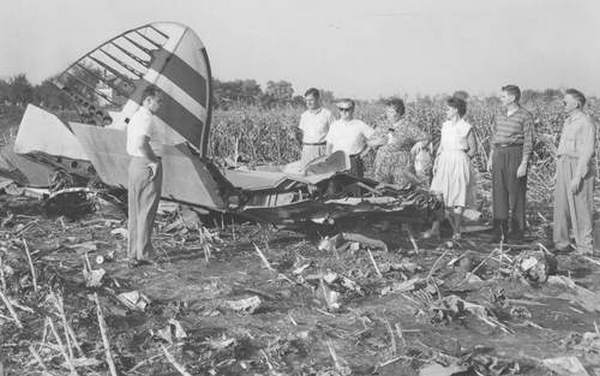
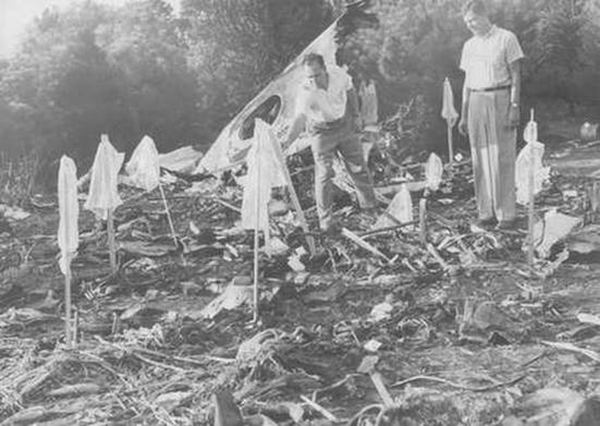
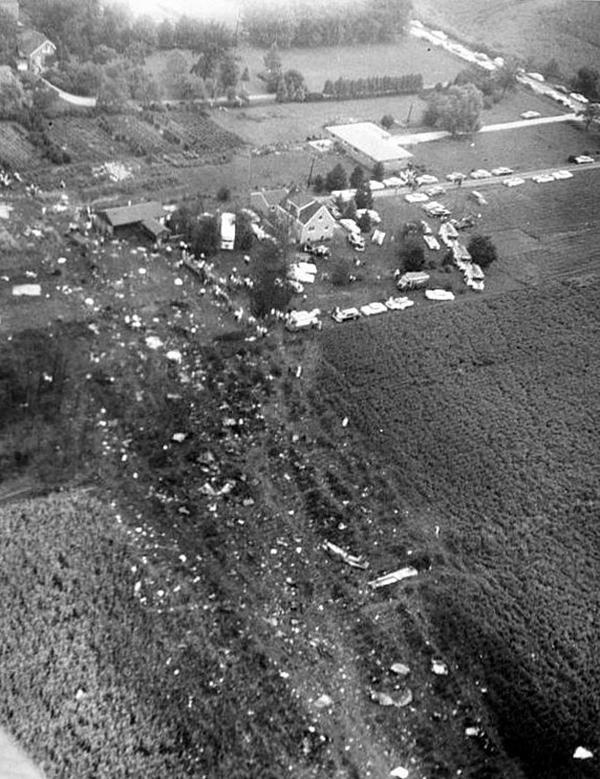
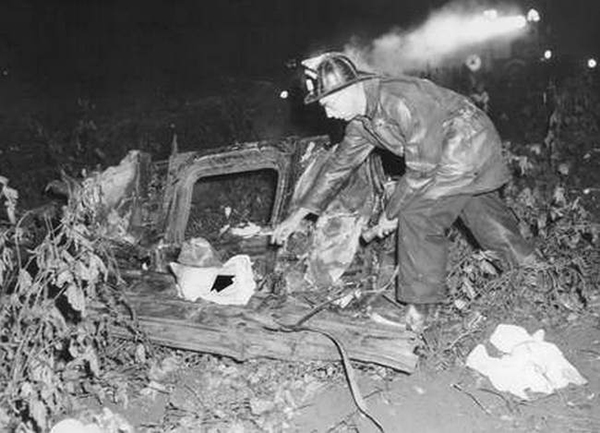
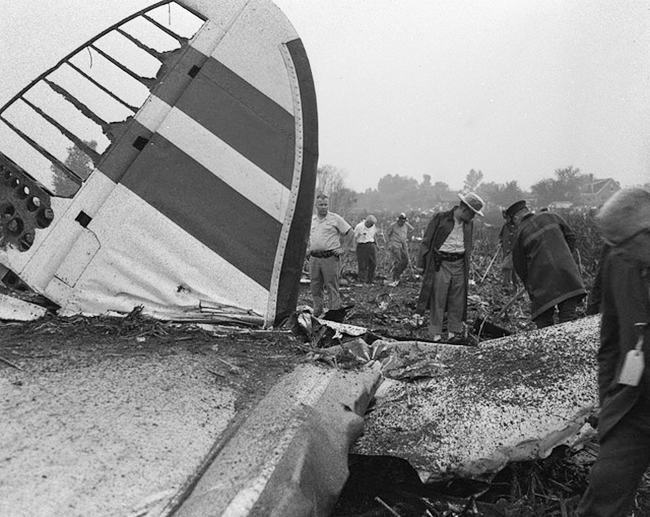
Crash of a Lockheed L-049 Constellation in Belo Horizonte
Date & Time:
Jan 26, 1961 at 1100 LT
Registration:
PP-PDC
Survivors:
Yes
MSN:
2056
YOM:
1946
Crew on board:
6
Crew fatalities:
Pax on board:
53
Pax fatalities:
Other fatalities:
Total fatalities:
0
Circumstances:
Following a wrong approach configuration, the four engine aircraft christened 'Domingos Dias Prado' landed too far down the runway. Unable to stop within the remaining distance, the airplane overran and eventually crashed into a ravine. All 59 occupants were evacuated safely while the aircraft was damaged beyond repair.
Probable cause:
Wrong approach configuration on part of the flying crew who completed the approach too high above the glide and at an excessive speed, causing the aircraft to land too far down the runway. It is also reported that the crew failed to make a go around while the approach procedure was missed.
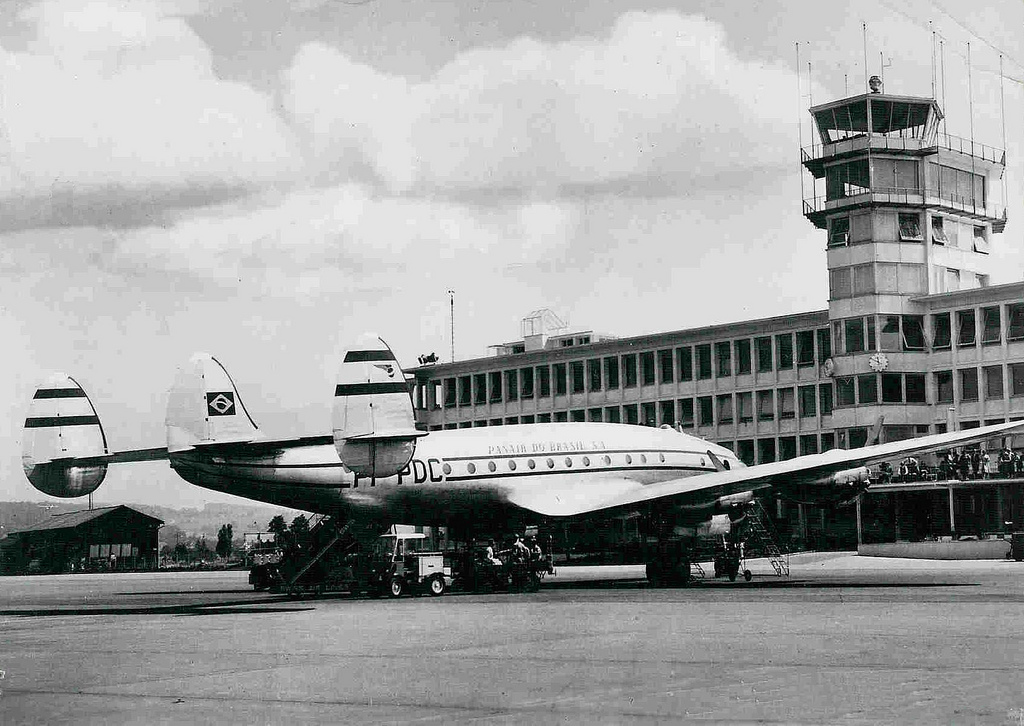
Crash of a Lockheed L-049E-46 Constellation in Charleston: 2 killed
Date & Time:
May 12, 1959 at 1520 LT
Registration:
N2735A
Survivors:
Yes
Schedule:
Washington DC – Rochester – Buffalo – New York – Pittsburgh – Charleston – Atlanta
MSN:
1978
YOM:
1946
Flight number:
CA983
Crew on board:
6
Crew fatalities:
Pax on board:
38
Pax fatalities:
Other fatalities:
Total fatalities:
2
Captain / Total hours on type:
408.00
Copilot / Total hours on type:
822
Aircraft flight hours:
29589
Circumstances:
Capital Airlines Flight 983 of May 12, 1959, a Constellation model L-049, N 2735A, following a landing at 1529 e.s.t., on a wet runway, was intentionally ground looped and during the maneuver skidded and slid down a steep embankment beyond the boundary of the airport at Charleston, West Virginia. One of the 38 passengers and one of the six crew members died in the fire which followed; one passenger was seriously burned amd all others on board the aircraft escaped with little or no injury; the aircraft was destroyed. The aircraft was landed within the first third of the runway and the captain said that finding braking to be ineffective, he chose to ground loop the aircraft rather than risk going down a sharp declivity at the far end of the runway. The aircraft left the runway about 600 feet from the far end. Investigation revealed operational deficiencies in the conduct of the approach and touchdown, and that crew coordination throughout the emergency was poor. Because of crew statements, the brakes were believed to have been capable of functioning in a normal manner; however, water on the runway would have permitted the aircraft to aquaplane and thus make them ineffective.
Probable cause:
The Board determines that the probable cause of this accident was the pilot's action of landing the aircraft too fast on the wet runway under conditions conducive to aquaplaning, making early deceleration impossible. An additional factor was the poor coordination of the crew throughout the approach and landing.
Final Report:
Crash of a Lockheed L-049 Constellation in Petrich: 58 killed
Date & Time:
Jul 27, 1955 at 0738 LT
Registration:
4X-AKC
Survivors:
No
Schedule:
London – Paris – Vienna – Tel Aviv
MSN:
1968
YOM:
1945
Flight number:
LY402
Crew on board:
7
Crew fatalities:
Pax on board:
51
Pax fatalities:
Other fatalities:
Total fatalities:
58
Circumstances:
The aircraft took off at 2015 GMT on 26 July from London for Tel Aviv with stops at Paris and Vienna. On 27 July it departed (0253 hours) Vienna with an estimated time of arrival over Belgrade of 0436 hours. While in the area of the Yugoslav-Bulgarian border at an altitude of approximately 18,000 feet the aircraft was fired upon by two Bulgarian fighters. Following two more attacks the aircraft broke up in mid-air at an altitude of 2,000 feet and fell to the ground in flames at a point 3,5 km southeast of the junction of the Rivers Strumica and Strumon in Bulgarian territory near the Bulgarian-Greek border. All 58 occupants have been killed.
Probable cause:
The aircraft sustained a hit or hits which caused loss of pressurization and a fire in the heater compartment. The aircraft broke up in mid-air due to explosion caused by bullets hitting the right wing and probably the left wing together with a projectile or projectiles of large calibre bursting in the rear end of the fuselage. Nevertheless, it was determined that the airplane deviated from its route, violated the State frontier of Bulgaria and penetrated deep into the interior of the Bulgarian airspace without warning. Equipped as it was with perfect air navigation devices, the airplane cannot have been unaware of the fact that it violated the State frontier of Bulgaria. Even after it had been warned, it failed to comply and continued to fly southwards in the direction of the Bulgarian-Greek frontier. The Bulgarian air defense forces acted with some hastiness and did not take all necessary measures to compel the aircraft to surrender and land. The Bulgarian Government considers it necessary to draw attention also to the fact that, for many years, certain parties, failing to respect the sovereignty of the Bulgarian People's Republic, have systematically been violating the Bulgarian frontiers. In recent years many illegal crossings of the Bulgarian frontiers by airplanes 'of unknown nationality' have been recorded. During these illegal flights, subverters equipped with arms, radio stations and other supplies were parachuted into Bulgarian territory. The Government of the Bulgarian People's Republic protested several times to the Secretariat of the United Nations Organization. Unfortunately, however, this produced no results. All these factors created a tense atmosphere which made it necessary to take steps to safeguard the security of the State. It was this tense atmosphere that made possible the unfortunate accident to the Israeli airplane.
Final Report:
